|
|
|
Sort Order |
|
|
|
Items / Page
|
|
|
|
|
|
|
| Srl | Item |
| 1 |
ID:
113320
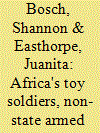

|
|
|
|
|
| Publication |
2012.
|
| Summary/Abstract |
Armed conflict on the African continent has witnessed increasing recruitment of child soldiers, often at the hands of non-state armed groups. Unfortunately this practice continues unabated in the face of legal obligations prohibiting the recruitment of child soldiers under international humanitarian law, and international and regional human rights law. While international condemnation of the practice has led to attempts to increase the minimum age for recruitment to 18, a disjuncture persists between the legal obligations states sign up to, and the actual enforcement of these prohibitions at a domestic level.
International criminal law jurisprudence emanating from the Special Court for Sierra Leone and the International Criminal Court is being monitored closely, as these courts seek to enforce the prohibition in all armed conflicts, and against both state actors and non-state armed groups. International humanitarian law only protects child soldiers who have been unlawfully recruited. In this piece, the authors take a closer look at what amounts to unlawful recruitment in light of customary international humanitarian law, since this body of law also binds non-state actors, even without further criminalising legislation at a domestic level. Moreover, the article briefly explores whether a child can ever void this protected status by volunteering to participate directly in hostilities.
|
|
|
|
|
|
|
|
|
|
|
|
|
|
|
|
| 2 |
ID:
064228
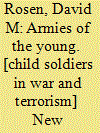

|
|
|
|
|
| Publication |
New Brunswick, Rutgers university press, 2005.
|
| Description |
xiii, 199p.
|
| Series |
Rutgers series in childhood studies
|
| Standard Number |
0813535689
|
|
|
|
|
|
|
|
|
|
|
|
Copies: C:1/I:0,R:0,Q:0
Circulation
| Accession# | Call# | Current Location | Status | Policy | Location |
| 049858 | 355.0083/ROS 049858 | Main | On Shelf | General | |
|
|
|
|
| 3 |
ID:
107343
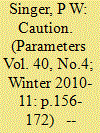

|
|
|
| 4 |
ID:
060968
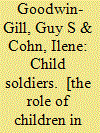

|
|
|
|
|
| Publication |
Oxford, Oxford University Press, 1994.
|
| Description |
228p.
|
| Standard Number |
0198259328
|
|
|
|
|
|
|
|
|
|
|
|
Copies: C:1/I:0,R:0,Q:0
Circulation
| Accession# | Call# | Current Location | Status | Policy | Location |
| 049525 | 341.481/GOD 049525 | Main | On Shelf | General | |
|
|
|
|
| 5 |
ID:
077560
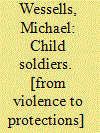

|
|
|
|
|
| Publication |
Cambridge, Harvard University Press, 2006.
|
| Description |
xv, 284p.
|
| Standard Number |
9780674023598
|
|
|
|
|
|
|
|
|
|
|
|
Copies: C:1/I:0,R:0,Q:0
Circulation
| Accession# | Call# | Current Location | Status | Policy | Location |
| 052398 | 355.33083/WES 052398 | Main | On Shelf | General | |
|
|
|
|
| 6 |
ID:
058365
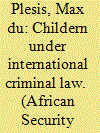

|
|
|
| 7 |
ID:
074906
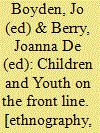

|
|
|
|
|
| Publication |
New York, Berghahn Books, 2005.
|
| Description |
xxvii, 274p.
|
| Standard Number |
15718188839
|
|
|
|
|
|
|
|
|
|
|
|
Copies: C:1/I:0,R:0,Q:0
Circulation
| Accession# | Call# | Current Location | Status | Policy | Location |
| 051906 | 305.23/BOY 051906 | Main | On Shelf | General | |
|
|
|
|
| 8 |
ID:
190846


|
|
|
|
|
| Summary/Abstract |
We introduce a new dataset, Contemporary Slavery in Armed Conflict (CSAC), coding instances and types of enslavement in armed conflict from 1989 to 2016, building on Uppsala Conflict Data Program data. CSAC currently covers 171 armed conflicts from 1989 to 2016, with the unit of analysis being the conflict-year. We identify different types of enslavement within these conflicts and find that 87% contained incidences of child soldiers, 34% included sexual exploitation/forced marriage, 23% included forced labor, and 16% contained instances of human trafficking. The use of enslavement in armed conflict to support strategic aims is also identified and found in about 17% of cases. Next, drawing upon key variables from the Uppsala Conflict Data Program, we present a series of cross-tabulations looking at the presence of slavery and conflict broken down by conflict incompatibility, intensity level, and type. We see the coding of slavery within conflict as a step toward generating greater understanding of when and how state and non-state actors use enslavement within conflict, with the goal of mitigating and possibly eradicating slavery in warfare.
|
|
|
|
|
|
|
|
|
|
|
|
|
|
|
|
| 9 |
ID:
154732
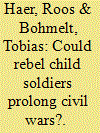

|
|
|
|
|
| Summary/Abstract |
While we know why rebels may recruit children for their cause, our understanding of the consequences of child soldiering by non-state armed groups remains limited. The following research contributes to addressing this by examining how rebels’ child recruitment practice affects the duration of internal armed conflicts. We advance the argument that child soldiering increases the strength of rebel organizations vis-a-vis the government. This, in turn, lowers the capability asymmetry between these non-state actors and the incumbent, allowing the former to sustain dispute. Ultimately, the duration of armed conflicts is likely to be prolonged. We analyse this relationship with quantitative data on child soldier recruitment by rebel groups in the post-1989 period. The results confirm our main hypothesis: disputes are substantially longer when rebels recruit children. This work has important implications for the study of armed conflicts, conflict duration and our understanding of child soldiering.
|
|
|
|
|
|
|
|
|
|
|
|
|
|
|
|
| 10 |
ID:
192063
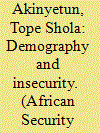

|
|
|
|
|
| Summary/Abstract |
Insecurity is a prominent phenomenon that threatens the peace and development of Africa in general and particularly, the Lake Chad Basin [LCB]. One of the factors driving the menace is the phenomenon of youth bulge. This article argues that young people with poor economic prospects are liable to be recruited for violence. Situated within the grievance model, the article shows how youth make up the larger percentage of protesting, violent and armed groups in the region and presents evidence of how grievance against deprivation moves demography to exacerbate insecurity. The article adopts a qualitative approach and relies on secondary data sourced from briefs, government reports, peer-reviewed journal articles and internet sources. The findings show that the endless supply of children and young people in the LCB is a major factor driving insecurity. By examining the phenomenon of Almajiri, child soldiers and youth radicalisation as enablers of conflict and insecurity in the LCB, the article concludes that population explosion amid a lack of resources leads to grievance and fuels insecurity. This is significant given the paucity of literature on the incidence of demography and insurgency in the LCB; which has become a theatre of insecurity in Africa.
|
|
|
|
|
|
|
|
|
|
|
|
|
|
|
|
| 11 |
ID:
068306
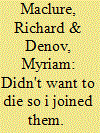

|
|
|
| 12 |
ID:
145595
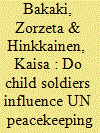

|
|
|
|
|
| Summary/Abstract |
The use of child soldiers in conflicts has received increasing academic attention in recent years. This article examines post-conflict periods to see whether the use of child soldiers mobilizes United Nations peacekeeping operations (UN PKO) in the aftermath of a conflict. Taking into consideration how child soldiers affect conflict and how important their reintegration is to sustainable peace and post-conflict development, we analyse whether the presence of child soldiers in a civil war increases the likelihood of the presence of a PKO. We argue that the UN deems a conflict with child soldiers as a difficult case for conflict resolution, necessitating a response from the international community. This is in line with our empirical results confirming that the use of child soldiers significantly increases the likelihood of peacekeeping.
|
|
|
|
|
|
|
|
|
|
|
|
|
|
|
|
| 13 |
ID:
141184
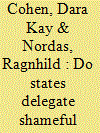

|
|
|
|
|
| Summary/Abstract |
Existing research maintains that governments delegate extreme, gratuitous, or excessively brutal violence to militias. However, analyzing all militias in armed conflicts from 1989 to 2009, we find that this argument does not account for the observed patterns of sexual violence, a form of violence that should be especially likely to be delegated by governments. Instead, we find that states commit sexual violence as a complement to—rather than a substitute for—violence perpetrated by militias. Rather than the logic of delegation, we argue that two characteristics of militia groups increase the probability of perpetrating sexual violence. First, we find that militias that have recruited children are associated with higher levels of sexual violence. This lends support to a socialization hypothesis, in which sexual violence may be used as a tool for building group cohesion. Second, we find that militias that were trained by states are associated with higher levels of sexual violence, which provides evidence for sexual violence as a “practice” of armed groups. These two complementary results suggest that militia-perpetrated sexual violence follows a different logic and is neither the result of delegation nor, perhaps, indiscipline.
|
|
|
|
|
|
|
|
|
|
|
|
|
|
|
|
| 14 |
ID:
165762
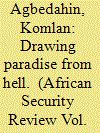

|
|
|
|
|
| Summary/Abstract |
This paper explores the nexus between child-soldiers’ wartime roles and their reintegration into the post-war society. Reintegration programmes do not suit all young veterans (former child soldiers). Many of these programmes do not result in their intended outcomes and literature has attempted to provide reasons for the failure or success of reintegration processes. The influence of young veterans’ war retentions, that is, skills, abilities, knowledge and practices gained through their wartime roles, on the reintegration process has not been adequately considered; this paper sets out to bridge this gap. The paper argues that wartime roles, far from being totally negative, could catalyse the reintegration process of some young veterans. While the paper partly concurs with the dominant apocalyptic description of the involvement of children in armed conflict, it argues that the experience gained from the war through combat, logistics, intelligence, reconnaissance and surveillance functions, is not always exclusively negative. Narratives collected from Liberian young veterans through in-depth interviews, attest to this. The paper also argues that the emphasis on the dominant role of killing and the harsh conditions of young veterans, tends to undermine any positive dimension of war retentions. The paper finally contests the view that there is diametrical opposition between wartime roles and post-war roles.
|
|
|
|
|
|
|
|
|
|
|
|
|
|
|
|
| 15 |
ID:
182564
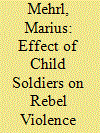

|
|
|
|
|
| Summary/Abstract |
Existing work describes child soldiers as very violent towards civilians. Challenging this, I posit that children’s effect on group behaviour is conditioned by rebels’ civilian support. Because they have weak pre-existing norms, children are both prone to normalize violence and susceptible to rebel efforts to control their use of violence. They should thus closely follow group rules in their behaviour towards civilians, implying a moderating effect of these rules. I expect that child soldiering increases civilian victimization only for groups who lack incentives to show restraint towards civilians because they receive no support from them. Empirical tests support this expectation.
|
|
|
|
|
|
|
|
|
|
|
|
|
|
|
|
| 16 |
ID:
080368
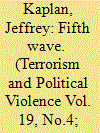

|
|
|
|
|
| Publication |
2007.
|
| Summary/Abstract |
This article builds on David Rapoport's Four Waves Theory by identifying several anomalous movements which did not appear to precisely fit with the internationalist model posited in Rapoport's Four Waves. Specifically, groups which I have called Fifth Wave movements have turned inward, becoming localistic rather than international, and manifest intense ethnic, racial, or tribal mysticism. They are millenarian and chiliastic in nature, and seek to create a new society - based on the creation of new men and women - in a single generation. Fifth Wave movements thus focus strongly on women and see children as the vanguard of their movements. Following this logic, rape is their signature tactic and child abduction their normal recruiting practice. This study posits the pre-state Khmer Rouge in Cambodia as the avatar of the current Fifth Wave, but finds that after a nearly generation-long hiatus, the fifth wave in its fully modern form emerged in Africa with the Lord's Resistance Army in Uganda as its paradigmatic exemplar
|
|
|
|
|
|
|
|
|
|
|
|
|
|
|
|
| 17 |
ID:
178008
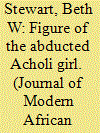

|
|
|
|
|
| Summary/Abstract |
Based on analysis of newspapers and secondary sources, this article examines the gendered construction of the national imagery of the war between the Ugandan government and the Lord's Resistance Army (LRA) in an effort to expand current conceptual understanding of the exclusion experienced by children born of forced marriage inside the LRA. Uganda developed as a militarised and masculine post-colony and yet nation-building for President Museveni involved crafting a national imagery that drew upon development discourses of gender and children to position himself as the benevolent father of the nation. Invoking Veena Das’ ‘figure of the abducted woman’, I argue that the Ugandan government mobilised the figure of the abducted Acholi girl to legitimise both its governance and the war. The article concludes that the resulting narrative provided no legitimate social or political space in the national imagery for the children of the abducted girls.
|
|
|
|
|
|
|
|
|
|
|
|
|
|
|
|
| 18 |
ID:
154975
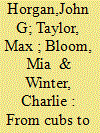

|
|
|
|
|
| Summary/Abstract |
Using the Islamic State in Iraq and al-Sham (ISIS) as a case study, we explore the process by which children evolve from novice recruits to fully fledged members of a violent extremist movement. From currently available data, we propose six stages of child socialization to ISIS—Seduction, Schooling, Selection, Subjugation, Specialization, and Stationing. Furthermore, we explore this process in the context of “Community of Practice” (COP) as developed by Wenger and Lave. COP models highlight how newcomers learn and pass through degrees of involvement from the periphery of an organization to the inside. In subsequent research, Hundeide highlighted how “contracts of deep commitment” and “conversion” constitute important social and psychological elements of communities of practice. We regard such qualities as intrinsic to children's involvement in ISIS. We conclude with implications drawn from the disengagement and reintegration experiences of former child soldiers in other contexts.
|
|
|
|
|
|
|
|
|
|
|
|
|
|
|
|
| 19 |
ID:
166691
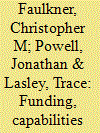

|
|
|
|
|
| Summary/Abstract |
Recent years have seen increased scholarly attention given to the issue of child soldiering. Primarily dedicated to the decision-making calculus of rebel groups, this body of work has generally emphasised supply-side versus demand-side arguments. We contribute to this growing literature by explicitly investigating a previously untested aspect of the latter. Prior scholarship has made vague references to a potential association between economic endowments and child soldiering, including natural resource wealth, but scant empirical attention has been given. We argue that the specific type of endowment has important consequences for the decision to utilise child soldiers. We argue access to and exploitation of lootable natural resources (e.g. gemstones) to be especially likely to promote the use of child soldiers due to their ease of access, the low skills required to harness them and the heightened likelihood that groups will become more profit-oriented. A systematic cross-national investigation of rebel groups provides robust evidence that lootable resources such as diamonds and gemstones are strongly associated with the use of children, while non-lootable resources such as oil are not.
|
|
|
|
|
|
|
|
|
|
|
|
|
|
|
|
| 20 |
ID:
089744
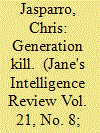

|
|
|
|
|
| Publication |
2009.
|
| Summary/Abstract |
There has been a rash of reports in the past two years about child soldiers and suicide bombers being recruited in Afghanistan, Iraq and Pakistan. This article analyses hwo indoctrine of youths remains a serious challenge for counter-insurgency practitioners.
|
|
|
|
|
|
|
|
|
|
|
|
|
|
|
|
|
|
|
|
|